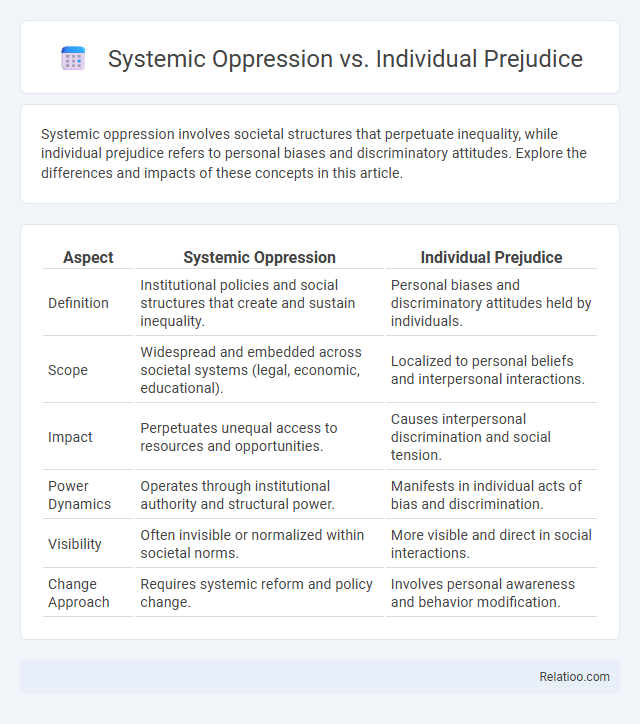Systemic oppression involves societal structures that perpetuate inequality, while individual prejudice refers to personal biases and discriminatory attitudes. Explore the differences and impacts of these concepts in this article.
Table of Comparison
| Aspect | Systemic Oppression | Individual Prejudice |
|---|---|---|
| Definition | Institutional policies and social structures that create and sustain inequality. | Personal biases and discriminatory attitudes held by individuals. |
| Scope | Widespread and embedded across societal systems (legal, economic, educational). | Localized to personal beliefs and interpersonal interactions. |
| Impact | Perpetuates unequal access to resources and opportunities. | Causes interpersonal discrimination and social tension. |
| Power Dynamics | Operates through institutional authority and structural power. | Manifests in individual acts of bias and discrimination. |
| Visibility | Often invisible or normalized within societal norms. | More visible and direct in social interactions. |
| Change Approach | Requires systemic reform and policy change. | Involves personal awareness and behavior modification. |
Understanding Systemic Oppression
Systemic oppression refers to the entrenched policies, institutions, and societal structures that systematically disadvantage certain groups, unlike individual prejudice, which involves personal biases or attitudes. Understanding systemic oppression helps you recognize how power dynamics and historical contexts perpetuate inequities beyond personal actions. Addressing these embedded inequalities requires examining and reforming the broader systems rather than focusing solely on individual behaviors.
Defining Individual Prejudice
Individual prejudice refers to personal biases, attitudes, or beliefs one holds against a group based on characteristics such as race, gender, or religion, often rooted in stereotypes and misinformation. It differs from systemic oppression, which involves institutional policies and social structures that perpetuate inequality on a broad scale. While oppression is the broader phenomenon encompassing both systemic forces and personal biases, individual prejudice manifests as discriminatory behavior or negative judgments by individuals.
Historical Roots of Systemic Oppression
Systemic oppression has deep historical roots embedded in institutions, laws, and social norms that perpetuate inequality across generations. Unlike individual prejudice, which involves personal biases and attitudes, systemic oppression operates through established structures such as legal systems, education, and economic policies that disproportionately disadvantage marginalized groups. Understanding these historical foundations is essential for recognizing how your experiences may be influenced by ongoing institutional barriers rather than isolated acts of discrimination.
Mechanisms of Systemic Oppression in Society
Systemic oppression operates through institutional policies, cultural norms, and social practices that disproportionately disadvantage certain groups, embedding inequality into the fabric of society. Unlike individual prejudice, which stems from personal biases or attitudes, systemic oppression manifests through laws, economic structures, and educational systems that perpetuate disparities regardless of individual intent. Understanding these mechanisms helps you recognize how deeply rooted inequalities affect opportunities and outcomes across diverse populations.
Personal Bias vs. Institutional Discrimination
Systemic oppression refers to institutional discrimination embedded in policies and social structures that perpetuate inequality across society, while individual prejudice encompasses personal biases based on stereotypes or unfounded judgments. Your personal bias can influence interactions, but systemic oppression enforces these biases through laws and practices that disadvantage entire groups. Understanding the distinction between personal prejudice and institutional discrimination is crucial for addressing both immediate attitudes and long-term societal change.
Real-World Examples: Systemic vs. Individual
Systemic oppression manifests through institutional policies and societal structures that disproportionately marginalize groups, such as racial segregation laws or discriminatory housing practices exemplified by redlining in the United States. Individual prejudice involves personal biases and discriminatory actions, like a hiring manager refusing to interview candidates based on ethnicity or gender. Understanding the distinction clarifies how systemic oppression persists beyond isolated prejudices, sustaining inequality on a broad scale.
Impact on Marginalized Communities
Systemic oppression embeds discriminatory policies and institutional practices that disproportionately disadvantage marginalized communities, limiting access to resources, education, and healthcare. Individual prejudice manifests as personal biases and discriminatory behaviors that reinforce social exclusion and psychological harm within these groups. While oppression encompasses both systemic and individual factors, its cumulative impact intensifies social inequalities and perpetuates cycles of marginalization across generations.
Intersectionality and Layers of Oppression
Systemic oppression refers to institutional policies and societal structures that create and maintain unequal power dynamics affecting marginalized groups, while individual prejudice involves personal biases and discriminatory attitudes. Intersectionality highlights how overlapping identities such as race, gender, and class compound experiences of oppression, producing unique layers of disadvantage. Understanding the interplay of systemic systems and individual acts of prejudice reveals the complex, multifaceted nature of oppression across social contexts.
Addressing Systemic Change vs. Personal Accountability
Systemic oppression refers to entrenched policies and institutional practices that perpetuate inequality across society, while individual prejudice reflects personal biases or discriminatory attitudes. Addressing systemic change requires comprehensive reform of laws, education, and social structures to dismantle these widespread inequalities. Your role in personal accountability complements this by challenging internalized biases and fostering inclusive behaviors that support broader societal transformation.
Moving Forward: Solutions and Social Responsibility
Addressing systemic oppression requires structural reforms such as policy changes, equitable resource distribution, and institutional accountability to dismantle entrenched inequalities. Individual prejudice must be confronted through education, awareness campaigns, and active allyship that challenge biases and promote inclusivity. Social responsibility involves collective action from governments, organizations, and communities to foster social justice, empower marginalized groups, and create sustainable change beyond personal attitudes.

Infographic: Systemic Oppression vs Individual Prejudice
 relatioo.com
relatioo.com